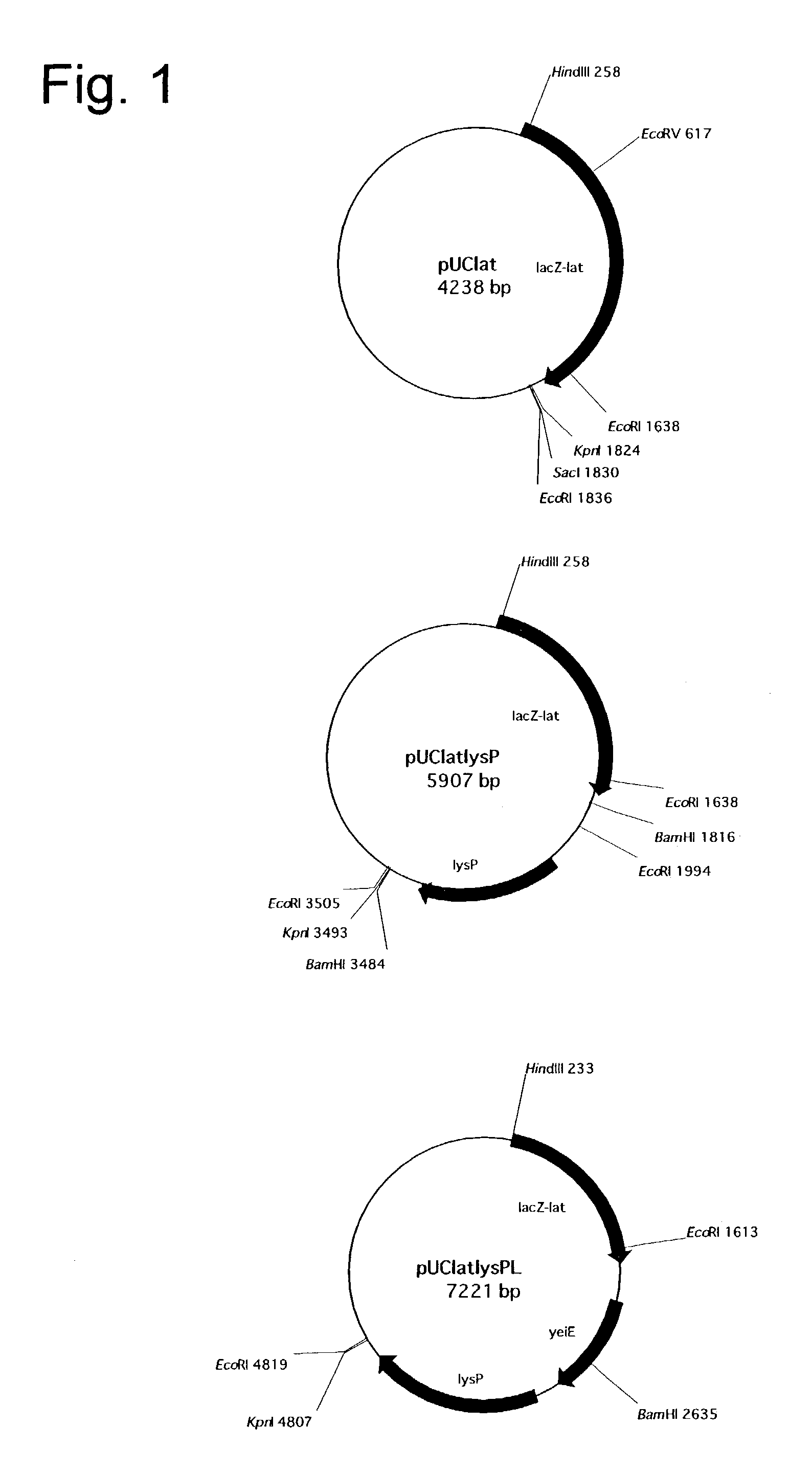Process for the biological production of L-pipecolic acid
a technology of lpipecolic acid and biological production, which is applied in the direction of biochemistry apparatus and processes, microorganisms, enzymes, etc., can solve the problems of difficult to utilize such biological pathways for the mass high cost of optical resolving agent, and no process for the production of lpipecolic acid by using these organisms has been put to practical use, etc., to achieve the effect of producing lpipecolic acid efficiently
- Summary
- Abstract
- Description
- Claims
- Application Information
AI Technical Summary
Benefits of technology
Problems solved by technology
Method used
Image
Examples
example 1
[0062]L-Pipecolic acid production tests were carried out with respect to E. coli BL21pUClatlysP (FERM BP-7326) strain, E. coli BL21(DE3)pETlatlysP strain, E. coli C600pUClatlysP strain and E. coli BL21pUClatlysPL strain. Each strain was inoculated into 3 ml of L medium (1.0% polypeptone, 0.5% yeast extract, 0.5% NaCl, 0.1% glucose, pH 7.2) containing 50 μg / ml ampicillin sodium, and incubated at 32° C. overnight with shaking. The resulting cultures were used seed cultures, and 275 μl of each seed culture was inoculated into 27.5 ml of TB medium (0.44% glycerol, 1.33% Bacto-trypton, 2.67% Bacto-yeast extract, 0.21% KH2PO4, 1.14% K2HPO4) containing 100 μg / ml ampicillin sodium, and incubated at 32° C. for 4.5 hours with shaking. In the culture of a microorganism formed with a pET vector, such as E. coli BL21(DE3)pETlatlysP, 275 μl of 100 mM isopropyl-β-D-thiogalactopyranoside (IPTG) was added for the purpose of inducing lat, and the incubation was continued at 32° C. for an additional 4...
example 2
[0064]In order to elucidate the role of P5C reductase in L-pipecolic acid production, the ability to produce L-pipecolic acid was examined with respect to four recombinant strains formed by using proC-deficient E. coil RK4904 strain as the host, namely E. coli RK4904pUC19 strain, E. coli RK4904pUClat strain, E. coli RK4904pUCproC strain and E. coli RK4904pUClatproC strain. Each strain was inoculated into 3 ml of L medium (1.0% polypeptone, 0.5% yeast extract, 0.5% NaCl, 0.1% glucose, pH 7.2) containing 50 μg / ml ampicillin sodium, and incubated at 32° C. overnight with shaking. The resulting cultures were used seed cultures, and 275 μl of each seed culture was inoculated into 27.5 ml of TB medium (0.44% glycerol, 1.33% Bacto-trypton, 2.67% Bacto-yeast extract, 0.21% KH2PO4, 1.14% K2HPO4) containing 50 μg / ml ampicillin sodium, and incubated at 32° C. for 8 hours with shaking. Then, 500 μl of 50% L-lysine hydrochloride and 500 μl of 50% glycerol dissolved in a phosphate buffer (pH 6.8)...
example 3
[0065]An investigation on the carbon source of the culture medium was carried out by using E. coli C600pUClatlysP strain. As to the composition of the culture medium, there were used culture media obtained by substituting various carbon sources for the glycerol of TB medium (0.44% glycerol, 1.33% Bacto-trypton, 2.67% Bacto-yeast extract, 0.21% KH2PO4, 1.14% K2HPO4). As carbon sources, glycerol, sodium pyruvate, citric acid, propionic acid, maleic acid, lactic acid and DL-malic acid were examined. 25 ml of each culture medium was placed in a 250-ml Erlenmeyer flask and incubated at 32° C. with shaking. The amount of L-pipecolic acid accumulated after 24 hours of incubation was 4.8 g / l, 3.3 g / l, 2.8 g / l, 2.6 g / l, 3.5 g / l, 4.7 g / l and 4.7 g / l, respectively. This indicates that organic acids can be used as carbon sources in the present invention.
PUM
| Property | Measurement | Unit |
|---|---|---|
| pH | aaaaa | aaaaa |
| flow rate | aaaaa | aaaaa |
| column temperature | aaaaa | aaaaa |
Abstract
Description
Claims
Application Information
 Login to View More
Login to View More - R&D
- Intellectual Property
- Life Sciences
- Materials
- Tech Scout
- Unparalleled Data Quality
- Higher Quality Content
- 60% Fewer Hallucinations
Browse by: Latest US Patents, China's latest patents, Technical Efficacy Thesaurus, Application Domain, Technology Topic, Popular Technical Reports.
© 2025 PatSnap. All rights reserved.Legal|Privacy policy|Modern Slavery Act Transparency Statement|Sitemap|About US| Contact US: help@patsnap.com



